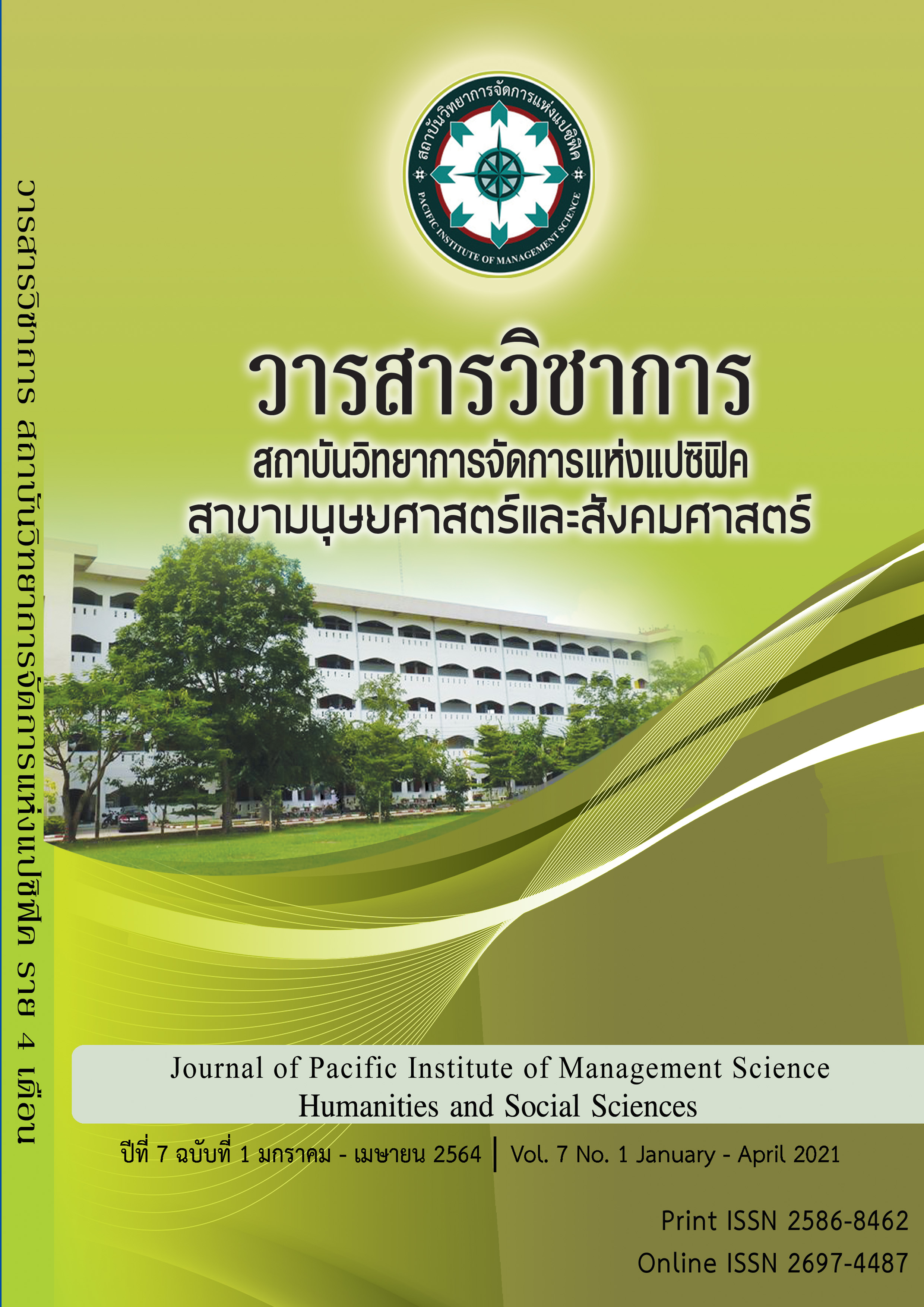ความสัมพันธ์โครงสร้างเชิงสาเหตุที่มีต่อการเติบโตอย่างยั่งยืน ของธุรกิจอาหารแช่แข็งในประเทศไทยในยุคเศรษฐกิจดิจิทัล
คำสำคัญ:
ความสัมพันธ์เชิงสาเหตุ, การเติบโตอย่างยั่งยืน, ธุรกิจอาหารแช่แข็งบทคัดย่อ
การวิจัยนี้ มีวัตถุประสงค์เพื่อ 1) เพื่อตรวจสอบความสอดคล้องของตัวแบบกับข้อมูลเชิงประจักษ์ของปัจจัยที่มีอิทธิพลต่อความสัมพันธ์โครงสร้างเชิงสาเหตุที่มีต่อการเติบโตอย่างยั่งยืนของธุรกิจอาหารแช่แข็งในประเทศไทยในยุคเศรษฐกิจดิจิทัล และ 2) เพื่อศึกษาอิทธิพลทางตรง ทางอ้อม และอิทธิพลรวม ของปัจจัยที่มีอิทธิพลต่อความสัมพันธ์โครงสร้างเชิงสาเหตุที่มีต่อการเติบโตอย่างยั่งยืนของธุรกิจอาหารแช่แข็งในประเทศไทยในยุคเศรษฐกิจดิจิทัล โดยเก็บข้อมูลจากผู้ผู้ประกอบการธุรกิจอาหารแช่แข็ง ในประเทศไทย จำนวน 385 ราย และทำการวิเคราะห์ข้อมูลด้วยโมเดลสมการโครงสร้าง (Structure Equation Model: SEM)
ผลการวิจัย พบว่า ผู้ประกอบการธุรกิจอาหารแช่แข็งในประเทศไทย มีระดับความคิดเห็นเกี่ยวกับปัจจัยกลยุทธ์ทางการตลาด ปัจจัยความสามารถเชิงพลวัต ปัจจัยการจัดการนวัตกรรมทางเทคโนโลยี ปัจจัยความสามารถทางการแข่งขัน และปัจจัยการเติบโตอย่างยั่งยืนของธุรกิจอยู่ในระดับมาก นอกจากนี้ยังพบว่า หลังจากใช้โปรแกรมสำเร็จรูปตรวจสอบความสอดคล้องของโมเดลสมการโครงสร้างปรากฏว่าดัชนีทุกตัวผ่านเกณฑ์มาตรฐาน ดังนั้น จึงสามารถสรุปได้ว่าผลการวิเคราะห์ที่ได้ครั้งนี้สอดคล้องกับข้อมูลเชิงประประจักษ์ และจากผลการวิเคราะห์เส้นทางพบว่า ปัจจัยกลยุทธ์ทางการตลาด ปัจจัยความสามารถเชิงพลวัต ปัจจัยการจัดการนวัตกรรมทางเทคโนโลยี ปัจจัยความสามารถทางการแข่งขัน มีอิทธิพลทางตรงต่อการเติบโตอย่างยั่งยืนของธุรกิจอาหารแช่แข็งในประเทศไทย อย่างมีนัยสำคัญทางสถิติ
เอกสารอ้างอิง
Anatan Lina. (2014). Factors Influencing Supply Chain Competitive Advantage and Performance. International Journal of Business and Information.
Barney, J. (1991). Firm resources and sustained competitive advantage. Journal of Management, 17(1), pp. 99-120.
Bierly, P.E., and Daly, P.S. (2007). Alternative Knowledge Strategies, Competitive Environment, and Organizational Performance in Small Manufacturing Firms. Entrepreneurship Theory & Practice, 31, 493-516.
Cetindamar & Ulusoy (2007). Innovation Performance And Partnerships Manufacturing Firms in Turkey. Journal of Manufacturing Technology Management, Vol. 19, No. 3, p. 332.
Deeds, D.L., Decarolis, D., and Coombs, J. (2000). Dynamic capabilities & new product development in high technology ventures: an empirical analysis of new biotechnology firm. Journal of Business Venturing, 15(3): 211-229.
Department of Business Development, Ministry of Commerce. (2018). Business Data Warehouse, from http://datawarehouse.dbd.go.th/bdw/home/login.html.
Diamantopoulos, A & Siguaw, A.D.(2000). Introducing LISREL: A Guide for the Uninitiated. Sage Publications: London.
Griffith, D. A., et al. (2006). The Performance Implications of Entrepreneurial Proclivity: A Dynamic Capabilities Approach. Journal of Retailing, 82(1): 51-62.
Kotler, P. (1997). Marketing management: analysis, planning implementation, and control. (9th). New Jersey: Asimmon &Schuster.
Leonidou, L. C., Palihawadana, D. & Theodosiou, M. (2011). National Export-Promotion Programs as Drivers of Organizational Resources and Capabilities: Effects on Strategy, Competitive Advantage, and Performance. Journal of International Marketing, 19(2), 1-29.
Lok, Peter & Crawford, John. (2001). Antecedents of organizational commitment and the mediating role of job satisfaction. Journal of Managerial Psychology. 16. 594-613.
Lyon & Ferrier (2002). Enhancing Performance with Product-Market innovation: The Influence of the Top Management Team. Journal Of managerial Issues Vol. 14, p. 452.
March, J. G. (1991). Exploration and Exploitation in Organizational Learning, 71.
Mehmet Koseoglu, Ezhan Karasan. (2013). Throughput modeling of single-hop CSMA networks with non-negligible propagation delay. IEEE Transactions on Communications.
Michael E. Porter. (1985). "TECHNOLOGY AND COMPETITIVE ADVANTAGE", Journal of Business Strategy, Vol. 5 Issue: 3, pp.60-78.
Michailova and Zhan. (2015). Dynamic capabilities and innovation in MNC subsidiaries. Journal of World Business, 50, 576-583.
Narasimhan, Om, Rajiv, Surendra and Dutta, Shantanu. (2006). Absorptive capacity in high-technology markets: the competitive advantage of the haves. Marketing Science, 25 (5). pp. 510-524. ISSN 0732-2399.
Nayyar, Praveen R. (1993). On The Measurement of Competitive Strategy Evidence from A Large Multiproduct U.S. Firm. Academy of Management Journal. 36 (6) pp. 1652 –1669.
Nunnally, J. C. (1978). Psychometric. theory (2nd ed.). New York: McGraw-Hill.
Office of International Trade Promotion (2017). Thai food industry Still occupies the world's number 1 export champion: the Intelligent Center for the Food Industry. Ministry of Commerce: Bangkok. [Online]. Available from http://www.ditp.go.th. [Retrieved 1 March 2019].
Robert S. Kaplan, David P. Norton. (1996). "strategic learning & the balanced scorecard", Strategy & Leadership, Vol. 24.
Shapiro (2006), Measuring Innovation: Beyond Revenue from New Products. Research-Technology Management, Vol. 49, p. 42.
Solomon, Michael R. (2013). Consumer Behavior: Buying, Having, and Being (8th ed.). NJ: Prentice-Hall.
Taniyaworawong .P . (2009). An Analytical Model of Competitiveness Factors of Thai Shoe Export Industry. Ph.D. in accordance with the Doctor of Philosophy degree program Business Administration Ramkhamhaeng university.
This .N, Bamrung .P, Kusanchai .S and Techajod .S . (2015, January-June). Competitive Advantage by Strategic Market Management in the Economic Change of One Tambon One Product Business in Chiang Rai Province. Modern Management Science, 8 (1), 153-164.
Tuan, N.P. & Yoshi, T. (2010). Organizational Capabilities, Competitive Advantage, and Performance in Supporting Industries in Vietnam. Asian Academy of Management Journal, 15(1), 1-21.
Wongmontha. S . (1999). Marketing Strategy. Marketing Planning. Bangkok: Thira Film and Sitex.
Zi-Lin, H. & Poh-Kam, W. (2004). Exploration vs. Exploitation: An Empirical Test of the Ambidexterity Hypothesis. [Article]. Organization Science, 15(4), 481-494.
ดาวน์โหลด
เผยแพร่แล้ว
ฉบับ
ประเภทบทความ
สัญญาอนุญาต
บทความที่ได้รับการตีพิมพ์เป็นลิขสิทธิ์ของ สถาบันวิทยาการจัดการแห่งแปซิฟิค
ข้อความที่ปรากฏในบทความแต่ละเรื่องในวารสารวิชาการเล่มนี้เป็นความคิดเห็นส่วนตัวของผู้เขียนแต่ละท่านไม่เกี่ยวข้องกับสถาบันวิทยาการจัดการแห่งแปซิฟิค และคณาจารย์ท่านอื่นๆในสถาบันฯ แต่อย่างใด ความรับผิดชอบองค์ประกอบทั้งหมดของบทความแต่ละเรื่องเป็นของผู้เขียนแต่ละท่าน หากมีความผิดพลาดใดๆ ผู้เขียนแต่ละท่านจะรับผิดชอบบทความของตนเองแต่ผู้เดียว







